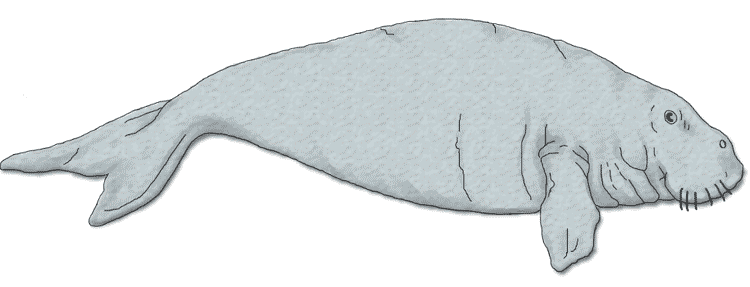- Evolution of sirenians
Sirenia is the order ofplacental mammal s which comprise modern "sea cows" (manatee s and theDugong ) and their extinct relatives. They are the only extantherbivorous marine mammals and the only group of herbivorous mammals to have become completely aquatic. Sirenians are thought to have a 50-million-year-oldfossil record (earlyEocene -recent). They attained modest diversity during theOligocene andMiocene , but have since declined as a result of climatic cooling, oceanographic changes, and human interference. Two genera and four species are extant: "Trichechus " which includes the three species of manatee that live along the Atlantic coasts and in rivers and coastlines ofthe Americas and westernAfrica , and "Dugong " which is found in the Indian and Pacific oceans.Early origins
thumb|right|Dugong .]
[
West Indian Manatee .]
[
West African Manatee .]
[
Steller's Sea Cow (extinct).] Sirenians, along withProboscidea (elephants), group together with the extinctDesmostylia and likely the extinctEmbrithopoda to form theTethytheria . Tethytheria is interpreted to have evolved from primitive hoofed mammals known ascondylarth s, along the shores of the ancientTethys Ocean .Tethytheria, combined with
Hyracoidea (hyraxes) forms an inclusive group calledPaenungulata . Paenungulata and Tethytheria (especially the latter) are among the least controversial mammalian orders, with strong support from morphological and molecular interpretations. The ancestry of Sirenia is remote from that ofCetacea andPinnipedia , though they are thought to have evolved an aquatic lifestyle around the same time.Fossil history
The first appearance of sirenians in the fossil record was during the early Eocene, and by the late Eocene, sirenians had significantly diversified. Inhabitants of rivers, estuaries, and nearshore marine waters, they were able to spread rapidly. The most primitive sirenian known to date, "
Prorastomus ", was found in Jamaica, not theOld World .The earliest known sea cows, of the families
Prorastomidae andProtosirenidae , are both confined to the Eocene, and were about the size of a pig, four legged amphibious creatures. By the time the Eocene drew to a close, came the appearance of theDugongidae ; sirenians had acquired their familiar fully-aquatic streamlined body with flipper-like front legs with no hind limbs, powerful tail with horizontal caudal fin, with up and down movements which move them through the water, like cetaceans.The last of the sirenian families who made their appearance,
Trichechidae , apparently arose from early dugongids in the late Eocene or early Oligocene. The current fossil record documents all major stages in hindlimb and pelvic reduction to the extreme reduction in the modern manatee pelvis, providing an example of dramatic morphological change among fossil vertebrates.Since sirenians first evolved, they have been herbivores, likely depending on
seagrass es and aquaticangiosperm s (flowering plants) for food. To the present, almost all have remained tropical, marine and angiosperm consumers. Sea cows are shallow divers with large lungs. They have heavy skeletons to help them stay submerged; the bones arepachyostotic (swollen) andosteosclerotic (dense), especially the ribs which are often found as fossils.Eocene sirenians, like
Mesozoic mammals but in contrast to otherCenozoic ones, have five instead of four premolars, giving them a 3.1.5.3 dental formula. Whether this condition is truly a primitive retention in sirenians is still under debate.Although cheek teeth are relied on for identifying species in other mammals, they do not vary to a significant degree among sirenians in their morphology, but are almost always low-crowned (
brachyodont ) with two rows of large, rounded cusps (bunobilophodont ). The most easily identifiable parts of sirenian skeletons are the skull and mandible, especially the frontal and other skull bones. With the exception of a pair of tusk-like first upper incisors present in most species, front teeth (incisors and canines) are lacking in all, except the earliest sirenians.See also
*
Evolution of cetaceans References
*Sirenian Evolution, Daryl P. Domning; Encyclopedia of Marine Mammals Perrin, Würsig and Thewissen
* [http://www.edwardtbabinski.us/manatee/sirenians.html Origin of Sirenians]External links
* [http://darla.neoucom.edu/DEPTS/ANAT/Thewissen/fos_man_ele/index.html Manatee and Elephant Fossils]
Wikimedia Foundation. 2010.


